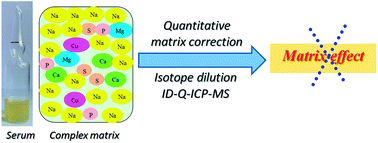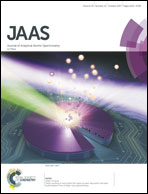Quantitative correction of matrix effects in the determination of copper in human serum by isotope dilution quadrupole ICP-MS
Abstract
Isotope Dilution Inductively Coupled Plasma Mass Spectrometry (ID-ICP-MS) has been applied to the accurate determination of elements in human serum. However, in the determination of Cu, because of high Na concentration (approximate 3500 μg g−1) and other potential interfering elements (such as Ca, Mg, P and S), it is often a considerably difficult matter to accurately determine the 63Cu/65Cu ratio in the isotope dilution quadrupole ICP-MS (ID-Q-ICP-MS) procedure. In this study, a method for the quantitative correction of matrix effects is presented in the analysis of Cu in a human serum sample by ID-Q-ICP-MS. The potential matrix effects induced by non-spectral and spectral interference are fully investigated, and the polyatomic interference caused by high concentration of Na is proved to be the most important source of matrix effects in Cu determination. On this basis, a series of simulated Na matrix solutions with different 63Cu/65Cu ratios (from 0.1158 to 2.2440) are prepared to confirm the matrix correction factor, which is used for matrix correction after subsequent standard-sample bracketing (SSB) mass bias correction during ID-ICP-MS analysis. Moreover, this methodology is validated by using high resolution (HR) ICP-MS, and the consistent results prove the validity of this quantitative correction strategy. This idea will help to open the way to certain applications involving isotope ratio measurements, which previously have been beyond the reach of quadrupole ICP-MS instruments.



 Please wait while we load your content...
Please wait while we load your content...